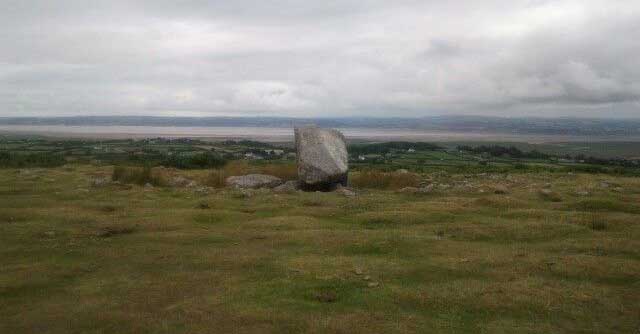Arthur's Stone
Describes several landmarks in Britain. The two best known are given below. The others have been omitted as there seems to be little or no legend attached to them, and they would appear to have been named Arthur's Stone for no particular reason relevant to King Arthur.
- The Peninsula of Gower, Wales
King Arthur's Stone, Maen CetiIt is said that, on his way to his final battle at Camlann, Arthur removed this stone from inside his boot and flung it into the distance, and it landed seven miles away at Cefn-y-Bryn.

At Cefn Bryn, Gower. Photographer: Unknown
At midnight on nights of the full moon, maidens from the Swansea area used to place cakes made of barley meal and honey, wetted with milk and well kneaded, on the stone. Then, on hands and knees, the maidens would crawl three times around the stone, this ritual being carried out to test the fidelity of their lovers. If the young men were faithful, they would come to the stone. If they did not arrive, the girls regarded this as a sign of their fickleness, or their intention never to marry.
Below the stone lies a spring called Fyfnnon Fawr that is supposed to run according to the ebb and flow of the tide. The water used to be drunk from the palm of one hand while a wish was made. On nights with a full moon a ghostly figure wearing shining armour emerges from under the stone and proceeds to Llanrhidian. Those who have seen this mysterious spectral figure claim that it is King Arthur.
This is a Neolithic burial tomb and one of the first sites to be protected under the Ancient Monuments Act of 1882. It dates back to 2500 BC. In fact this relic is an ancient burial chamber with four stones supporting a millstone-grit capstone, making it a prominent feature on the ridge. The huge capstone is thought to weigh about 25 tons, and has been partly split, either by King Arthur with Excalibur or by Saint David, who wished to prove that it was not a sacred stone. In 1870 the Egyptologist Sir Gardiner Wilkinson excavated the tomb, and claimed that the pathway followed by the ghostly apparition seen by many of King Arthur on a white steed, is the remains of a stone avenue.
- Dorstone, Herefordshire
It is said this is the stone from which Arthur pulled out Excalibur.
There is a confusion here: Excalibur was not the original sword in the stone. It is also said that Arthur is buried beneath the stone or that it marks the burial place of a king overcome by Arthur.
